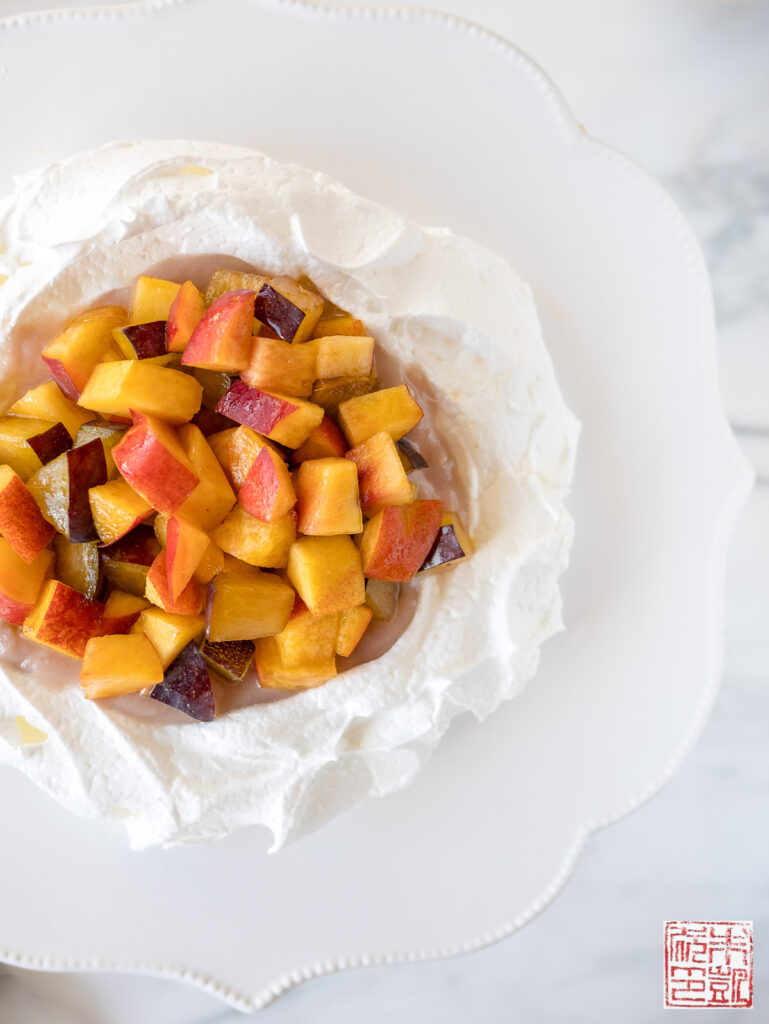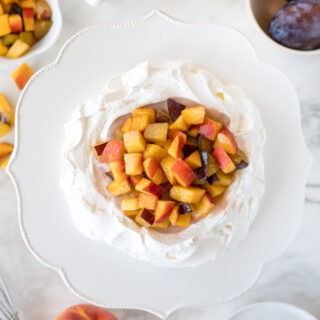
This stone fruit pavlova with guava curd is the perfect farewell to summer, and welcome to fall. What with the crazy abundance of stone fruit right now, and the weather still gloriously warm but with a hint of autumn coolness in the breeze, this seems like a lovely palate cleanser before we head into full-on pie season.
Click here to jump to recipe

This pavlova is inspired by the one I had at the recent Eat Drink SF event in San Francisco; Palette Tea House offered up these adorable mini pavlovas filled with peaches, plums, and a sweet guava curd. I loved them so much I was inspired to try and duplicate them at home.
You can use any mix of stone fruit that’s in season: I used peaches, nectarines, and plums, but go with what looks best at the market. You want to find some fruit that’s ripe but not too soft so you can still slice it cleanly.
I made guava curd the first time for my tropical layer cake and it was nice to revisit it. Depending on whether you use guava puree or already sweetened guava nectar, you can adjust the amount of sugar you use in the curd by a couple tablespoons; you don’t want the curd too sweet since the meringue itself it already pretty sweet, but I find that its bright tropical notes make a nice balance for the peaches and nectarines. It softens and rounds them out and turns the whole combination into a real dessert.

It almost never fails that every time I work with meringue, it’s a humid and/or rainy day. If it’s super wet, it might be best to change your plans, or don’t get down on yourself if it doesn’t turn out properly. The first time I made this meringue, it was an unusually muggy day for San Francisco and I clearly didn’t let it dry out in the oven long enough. I lucked out with slightly drier weather the next morning, made a couple small tweaks, and had much better success.
-Bake at a low temperature to prevent browning. I found that an hour in a 200 degree oven gave the meringues a crisp crust while the insides stayed soft and marshmallowy. Keeping the temperature low also helps keep the exteriors from browning. You can adjust as necessary for your particular oven; if you find your meringues are turning brown too quickly, try turning down the temperature down a bit. Also, turn off the oven and leave the meringues inside for a bit to let them finish drying after the baking time.
-Use aged egg whites (3-4 days old works well) and bring them to room temperature before whipping to get the most volume and stable peaks. Adding cream of tartar also helps stabilize the whipped egg whites.
-You can make one giant meringue with this recipe, but I split it into two to help them bake faster and more evenly, and for easier presentation. You can even make individual meringues, but watch their baking time more closely to make sure they don’t over brown.
Also a cautionary note: if you make a big meringue it can be a little fragile to move around so be careful. One of mine broke into pieces and I quickly realized I could make a version of Eton mess with the meringue pieces, curd, and fruit! So don’t worry, there’s a lot of ways to get a delicious dessert out of these components!
Happy Autumn!

- 1 large egg
- 3 tablespoons (33 g) sugar
- ¼ cup guava nectar or puree
- 1 ounce (20 g) unsalted butter, room temperature, cut into 1-in pieces
- 3 large egg whites, room temperature
- ½ teaspoon cream of tartar
- ¾ cup (150 g) sugar
- 2 teaspoons cornstarch
- 1 teaspoon white vinegar
- ¼ teaspoon almond extract
- Two peaches, nectarines, or other stone fruit
- Create a water bath by placing a saucepan of water over heat to simmer and placing a metal bowl unto the pan so its bottom does not touch the water. Whisk the eggs, sugar, and fruit nectar or puree together in a metal bowl.
- Cook the mixture over the simmering water, whisking constantly, until the curd reaches 180 degrees and thickens. Keep whisking while the mixture is heating up to prevent the eggs from cooking.
- Once the curd is thickened – you should be able to make tracks in the mixture with your whisk – take the curd off the heat. Let the curd rest for a bit until it cools to about 140 degrees.
- Add in the butter pieces a few at the time and whisk to combine.
- Pour into a container and chill in refrigerator before using.
- Preheat oven to 200 degrees F. Line a baking pan with parchment paper.
- Place egg whites and cream of tartar in a very clean metal mixing bowl fitted with a very clean whisk.
- Whip on medium speed until soft peaks form. They should hold together but the tips will still flop over.
- Gradually add in sugar while mixer is still running and whip on high until meringue is stiff and glossy. One test is to hold a spoonful of meringue upside down and see if it stays in place or slides off the spoon.
- Sift cornstarch over the meringue. Add in vinegar and almond extract and gently fold cornstarch, vinegar, and almond extract into the mixture.
- Spoon meringue into two equal portions on the prepared pan and form into roughly 8" round mounds. Use the back of the spoon to make a shallow well in center of each round.
- Bake for about an hour in the oven until dry and firm on the outside, and still soft on the inside.
- Turn off oven and leave meringues inside to cool while you cut up the fruit.
- Assemble shortly before you are ready to serve.
- Wash and cut up fruit into small pieces.
- Spoon guava curd into the center of the meringues.
- Arrange fruit on top. Serve immediately.



Beautiful pavlova! Perfect in these hot days!
Thank so so much! I’m glad with how it turned out!